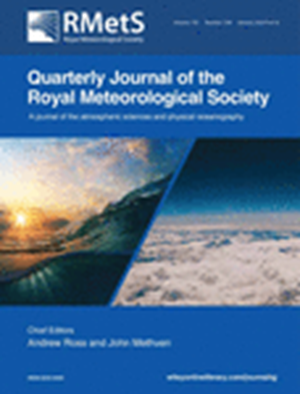非稳定分层大气流的频谱缩放:湍流各向异性和低频扩展
IF 2.9
3区 地球科学
Q2 METEOROLOGY & ATMOSPHERIC SCIENCES
引用次数: 0
摘要
利用惯性子范围特性和莫宁-奥布霍夫相似性理论缩放的不稳定表层速度和温度频谱,在低频处显示出明显的扩散。这里使用了 14 个数据集的大集合,包括相对简单的地形(从平坦均匀的地形到缓坡或谷底)和非常复杂的山地地形(陡坡、火山口边缘、山顶),以评估这种低频行为的原因。结果表明,湍流各向异性是造成最大尺度频谱密度分布以及流向和跨向速度频谱峰值位置的主要因素。另一方面,表面法向频谱的低频行为受稳定性影响的支配,而温度频谱的湍流各向异性和稳定性起着类似的作用。利用温度和速度方差的比例关系、湍流动能耗散和一半温度方差的比例关系,以及文献中提供的半经验模型,我们能够仅以湍流各向异性和稳定性作为输入参数来描述速度和温度谱的行为。虽然复杂地形数据集最大尺度的变化突出了湍流各向异性或稳定性以外的过程的影响,但这些观测结果在简单和复杂的山地地形上都是有效的。最后,我们对各向异性漩涡在不同稳定性下的尺度性质提出了一些见解。本文章由计算机程序翻译,如有差异,请以英文原文为准。
Spectral scaling of unstably stratified atmospheric flows: Turbulence anisotropy and the low‐frequency spread
Unstable surface‐layer velocity and temperature spectra, scaled using inertial subrange properties and Monin–Obukhov similarity theory, have been known to show a notable spread in low frequencies. Here, a large ensemble of 14 datasets, over relatively simple (from flat and homogeneous terrain to gentle slopes or valley floor) and very complex mountainous terrain (steep slopes, crater rim, mountain tops), is used to assess the reasons for this low‐frequency behaviour. Turbulence anisotropy is shown to be the primary factor accounting for the spread in the spectral density at the largest scales and the spectral peak position of streamwise and spanwise velocity spectra. On the other hand, the low‐frequency behaviour of surface‐normal spectra is dominated by stability effects, whereas for temperature spectra turbulence anisotropy and stability play a similar role. Using a combination of scaling relations for temperature and velocity variances as well as dissipation of turbulence kinetic energy and half the temperature variance, and of a semi‐empirical model provided in the literature, we are able to describe the behaviour of the velocity and temperature spectra with only turbulence anisotropy and stability as input parameters. These observations are valid over both simple and complex mountainous terrain, although variability of the largest scales of complex‐terrain datasets highlights the effect of processes other than turbulence anisotropy or stability. Finally, we provide some insights into the scalewise nature of anisotropic eddies under different stabilities.
求助全文
通过发布文献求助,成功后即可免费获取论文全文。
去求助
来源期刊
CiteScore
16.80
自引率
4.50%
发文量
163
审稿时长
3-8 weeks
期刊介绍:
The Quarterly Journal of the Royal Meteorological Society is a journal published by the Royal Meteorological Society. It aims to communicate and document new research in the atmospheric sciences and related fields. The journal is considered one of the leading publications in meteorology worldwide. It accepts articles, comprehensive review articles, and comments on published papers. It is published eight times a year, with additional special issues.
The Quarterly Journal has a wide readership of scientists in the atmospheric and related fields. It is indexed and abstracted in various databases, including Advanced Polymers Abstracts, Agricultural Engineering Abstracts, CAB Abstracts, CABDirect, COMPENDEX, CSA Civil Engineering Abstracts, Earthquake Engineering Abstracts, Engineered Materials Abstracts, Science Citation Index, SCOPUS, Web of Science, and more.

 求助内容:
求助内容: 应助结果提醒方式:
应助结果提醒方式:


